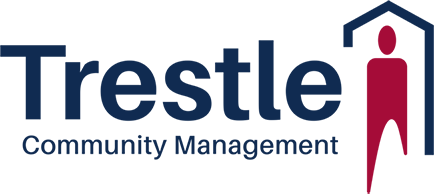Trestle Explains Community Association Annual Meetings
Under most community governing documents, an Annual Meeting of the HOA or Condo membership must be held each year. Oftentimes, this meeting is scheduled during the first quarter of the year though the timing may vary by community.
The Purpose of an Annual Meeting

An Association’s Annual Meeting presents an opportunity for Homeowners to join community leaders in reviewing the prior year’s accomplishments and challenges, discuss the upcoming year’s goals, and elect Board Members to serve the community. Commonly, this includes a review of the Association’s financials and a discussion about planned or anticipated projects and expenses. The meeting is a great opportunity for Homeowners to ensure their voice is heard and the Association is governed in the manner desired by its membership.
Quorum and the Annual Meeting
All Homeowners are invited to attend the Annual Meeting and have a say in the operation of their community. Effective governance of the Association is an important way to maintain the quality of life for residents and property value for Homeowners.
HOA and Condo Associations are required to have a specific percentage of Homeowners present at the meeting, either in person or by proxy, to conduct business. When preparing for the meeting, most governing documents require that the community send notices to all owners via regular mail. As a result, there is substantial cost and time associated with reserving a meeting space, preparing, and mailing notices, organizing an agenda and speakers when necessary, and holding the meeting.
Homeowners unable to attend their Annual Meeting are strongly encouraged to return the proxy provided with their meeting notice. A signed proxy allows the Association to count the Homeowner in the quorum requirement and allows the Association to proceed with the meeting.
Community Association Purpose and Creation
Associations serve to create a community for Homeowners. Pooling resources and utilizing centralized maintenance through the Board of Directors and other volunteers, Associations can maintain an appealing aesthetic, create a sense of community, and help Homeowners retain and increase their home values.
In Washington State, Community Associations, also known as Common Interest Ownership Associations, are corporations, often subject to the Washington State Nonprofit Corporation Act (Nonprofit Act). In addition, Associations are incorporated under one of four common interest ownership acts in Washington State and each Homeowner within the Association is considered a member as soon as they purchase a home.
As a corporation, each community must abide by the community association act it is incorporated under as well as the Association’s governing documents recorded with the State and the Non-Profit Corporation Act, if applicable. The applicability of each act depends on the date and way in which the Association was incorporated.
The four acts are:
- The Homeowners Association Act (HOA Act),
- The Horizontal Properties Regimes Act (Old Act),
- The Condominium Act (New Act), and
- The Washington Uniform Common Interest Ownership Act (WUCIOA).
Previously, an Association could be incorporated under any active Community Association act. However, with the passage of WUCIOA, all new communities incorporated after July 1, 2018, fall under the act.
The Role of the Board of Directors
As a corporation, the Association is run by a Board of Directors. Oftentimes, the Board consists of elected members from the community, though some governing documents allow non-Homeowners to run for Board positions. Additionally, communities under development may temporarily have builder representatives on the Board while the community continues to be built.
Each Association’s governing documents will outline the makeup of its Board of Directors, including how many members may serve on the Board of Directors and the required positions such as President, Vice President, Secretary and Treasurer.
The Board of Directors’ responsibilities are outlined in the community’s governing documents and often include the administration of the Association. Board Members are tasked with adhering to the Association’s legal requirements outlined in Washington State law and the Association’s governing documents. These requirements include maintenance of elements as defined in the documents. While each community is different, an Association is often responsible for the maintenance of common elements, which are items accessible to most, if not all, Homeowners. This would include items such as a monument sign, playground, lobby, and park.
A HOA or Condo Association may also be responsible for the maintenance of limited common elements, which generally include items used by one or more Homeowners and are often visible to the community. Though the Association may have the ability to seek reimbursement from affected Homeowners for these maintenance expenses.
How do Board Members Conduct Business?
The bulk of Association business is conducted during Board meetings. At these meetings, the Board discusses upcoming projects and plans, and makes necessary decisions to ensure the buildings and common elements are adequately maintained and the Association remains financially stable. Time sensitive matters may be addressed via email, video, or telephone conference between meetings.
Getting Involved
Homeowners interested in assisting in their community are encouraged to volunteer for the Board of Directors. Each community’s governing documents outline Board Members terms; they typically last for a period of 1 – 3 years. Depending on terms and vacancies, an election may or may not take place each year. However, when a position is available or a term has expired, interested Homeowners will have the opportunity to run for the Board and be elected at the Association’s Annual Meeting. To learn more, please contact your Community Association Manager using your community email address or our Client Experience Team at (425) 454-6404 or Hi@TrestleCM.com.
Connecting with Trestle
Trestle regularly connects on LinkedIn, Facebook, and Twitter, and can be contacted through its website or at (425) 454-6404.



